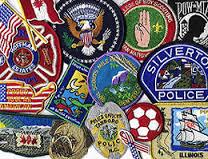The history of patches can be traced down in early history. Nowadays, an embroidered patch comes with various uses as it is widely utilized for military insignia, scout badges, sporting events and other similar activities. During the ancient times, especially in the Mediterranean and Middle Easy, embroidery was used to decorate the garments and other possessions of the rich.
The Beginning

The Use of Machines
While most patches are made by hand, most of them are machine-made. First introduced by Alphonse Kursheedt in the 1800s, the embroidery machine helped people combine different sets of looms and create great-looking hand embroidery. In order to come up with a mechanized process, Kursheedt imported twelve embroidery hand looms. Not long after, the Schiffli embroidery machine was created by Isaak Groebli after drawing inspiration from Kursheedt's creation. The Schiffli embroidery machine made use of a shuttle and a continuously threaded needle.
In today's modern world where technology reigns supreme, people can now use digitized patterns to come up with different embroidered designs through the use of computers. Now, people can mass produce embroidered patches for companies, sports teams, school uniforms, and other similar uses.
The Modern-Day Patch Creation Process
When it comes to creating a patch nowadays, computers mostly do the majority of the work. However, early ancestors have been using similar technology in the 17th and 18th Century BC. Technological advancements have been widely used during the Industrial Revolution in terms of making embroidery easily accessible to everybody. This is because embroidery was once a practice only fitting for the wealthy population since the process to decorate a clothing is deemed time-consuming. With the advent of sewing machines and embroidery hand looms, the efficiency of producing intricate designs has greatly increased which paved the way for the ordinary citizens to decorate their clothing.
Nowadays, people can embroider a patch with different designs and patterns with the help of multi-head sewing machines that are controlled by intricate computers. Unlike the wool-blend or all-cotton threads used by most people in the old days, people now use polyester-blended threads on embroidered patch as they retain color more effectively and more durable than their predecessor.
Application and Value
An embroidered patch is a cheap and efficient way of identifying individuals based on rank, talent or organization. In the United States, the military was one of the first government organizations to use a patch as a mean of identification. Military personnel belonging in a different division, rank and skill set, make use of varying patch designs. For example, those who belong in the armory division typically use a tank-inspired patch. On the other hand, those who belong in the medic division usually use a patch with the Red Cross design so that they can easily be distinguished on the battlefield.
The oldest US military patch known in existence is the renowned Big Red One which was utilized by the 1st Infantry Division. The said patch was first issues to the soldiers belonging in the said division in 1918. Now, the said patch is considered a collector's item with a great monetary value.
Final Thoughts
Patches are usually integrated into most clothing and other textile products nowadays. However, most people do not know the history behind the practice. Knowing the history behind why you are wearing a certain patch is a great way to know the value of the logo that you bear.
Author Bio:
Patches is handmade stuff and lots of materials used while its creation illustrates above. For more reference visit patches4less.
